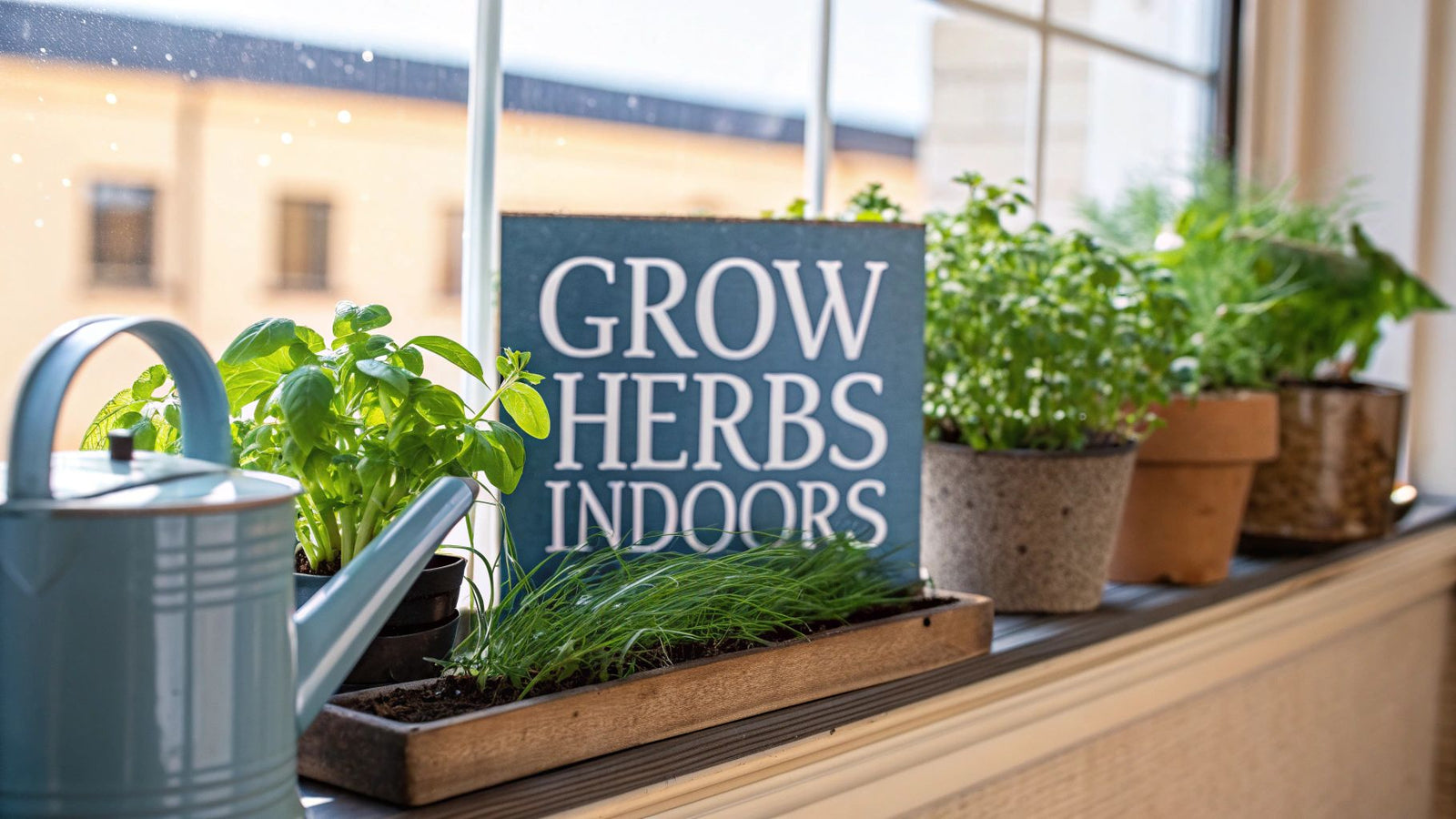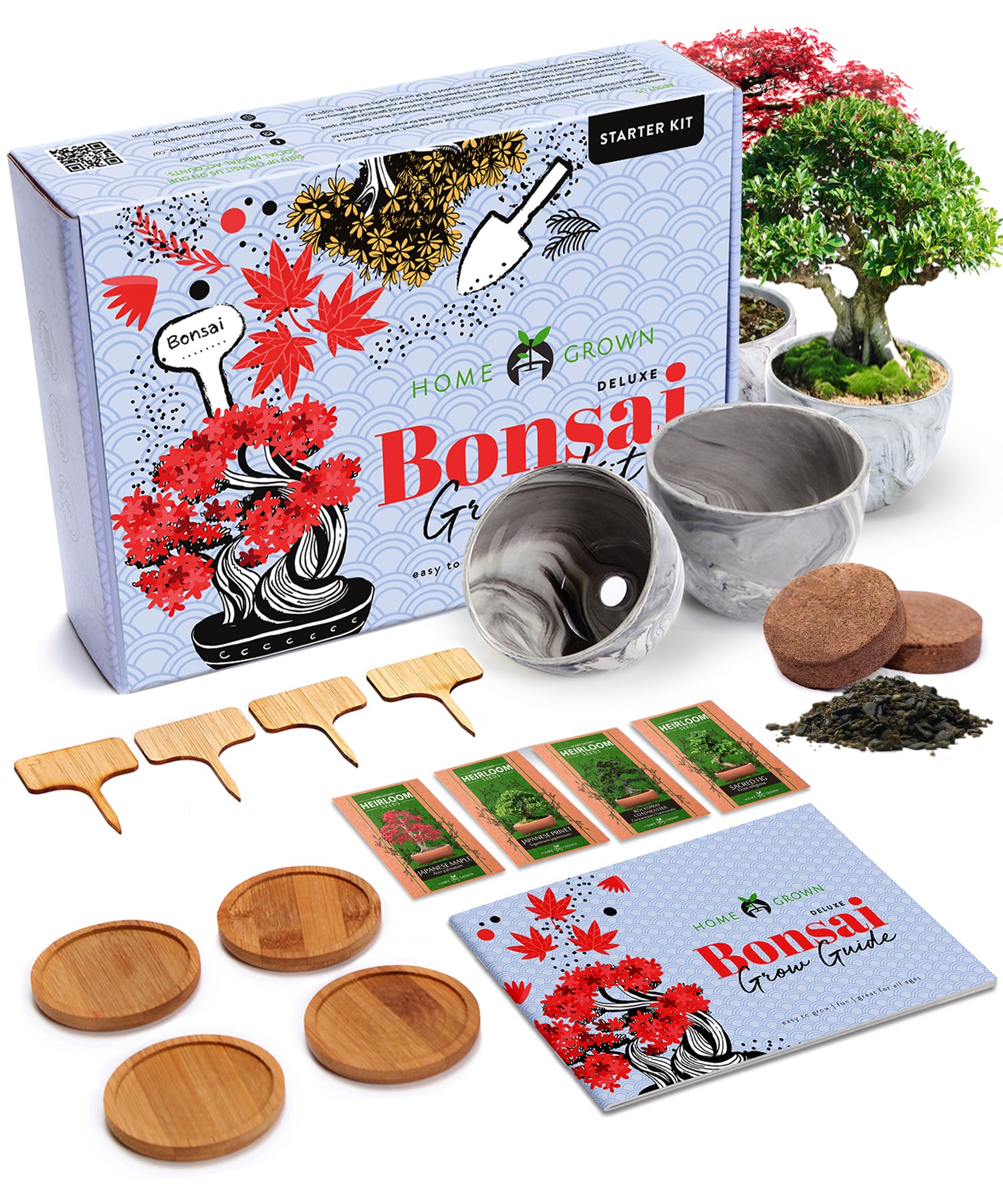
Of course you can grow a thriving herb garden indoors! The real secret isn't some mystical "green thumb"—it's simply knowing what your plants need to flourish. Once you get the hang of a few key elements, you'll be snipping fresh herbs for your meals in no time.
4 Fundamental Steps to Indoor Herb Gardening Success
Growing herbs inside is all about recreating their happy place, right on your windowsill or countertop. It’s a rewarding mix of art and science, where understanding how light, soil, and water work together allows you to turn even a small space into a productive little oasis.
To get started, let's focus on the four fundamentals that lay the groundwork for healthy roots, vibrant leaves, and incredible flavor.
1. Choose the Right Herbs
Not all herbs are created equal when it comes to indoor living. Start with easygoing, resilient varieties that adapt well to pots. Think basil, parsley, mint, and chives—these are the superstars of the windowsill garden.
2. Provide Plenty of Light
Light is food for plants, and most herbs are sun-worshippers. They need at least 6–8 hours of bright light each day to produce those flavorful essential oils. A sunny, south-facing window is ideal, but if you don't have one, a simple full-spectrum grow light works wonders.
3. Master Your Watering Routine
This is where most new gardeners trip up. Overwatering is the number one killer of indoor herbs! Instead of watering on a strict schedule, just check the soil. A good rule of thumb is to water only when the top inch of soil feels dry to the touch. This simple practice prevents root rot and keeps your plants happy.
4. Use Quality Soil
Herbs hate having "wet feet," so drainage is non-negotiable. Don't just scoop up dirt from your backyard. Instead, use a high-quality, well-draining potting mix. For an extra boost, look for one enriched with a bit of compost or mix in some perlite to improve aeration and drainage.
We've covered the core concepts for keeping your indoor herbs alive and well. The table below breaks it all down into a handy cheat sheet.
Indoor Herb Garden Success at a Glance
| Factor | Recommendation | Quick Tip |
|---|---|---|
| Herb Selection | Start with resilient varieties like basil, mint, and parsley. | Pick just 3–4 of your favorite herbs to start with to keep things manageable. |
| Light | Provide 6–8 hours of direct sun or supplemental LED light daily. | A south-facing window is your best friend for happy, sun-loving herbs. |
| Water | Water thoroughly only when the top 1 inch of soil is completely dry. | Always use pots with drainage holes and saucers to catch the excess water. |
| Soil | Use a well-draining potting mix, ideally with some added compost. | Mix in a handful of perlite to create air pockets and improve drainage. |
Think of this table as your recipe for success. With these basics in place, that empty spot on your counter can become a constant source of fresh, aromatic ingredients.
These fundamentals are really just about mimicking what nature does best: providing a balanced environment where plants can thrive. It’s amazing what a difference a few small adjustments can make. For example, simply moving your basil to a south-facing window and using a soil mix with perlite can boost its leaf production by up to 30%.
Did you know? Herbs grown indoors in a well-lit spot can often have a more concentrated and potent flavor than their outdoor counterparts.
By following this approach, any bright corner of your home can become your own personal mini-farm, putting fresh, vibrant flavor right at your fingertips. Get ready to enjoy the satisfaction of cooking with herbs you grew yourself
3 Reasons Why an Indoor Herb Garden Is More Than Just Decor

Sure, a few pots of herbs on the windowsill add a welcome splash of green to your kitchen. But that’s just the beginning. An indoor herb garden is a small change that can genuinely elevate your daily life, connecting you to your food and bringing a little piece of nature indoors.
Imagine snipping a few leaves of fresh basil for your pasta sauce or grabbing some mint for a drink, moments before you need it. That's a level of freshness and aroma you just can't get from a plastic container at the grocery store. Having living plants right in your kitchen does more than just taste good—it sparks a bit of creativity every time you cook.
- 1. Unbeatable Flavor: Nothing compares to the taste of herbs harvested right at their peak.
- 2. A Touch of Nature: It's a simple way to bring calming green visuals into even the tightest living spaces.
- 3. Healthy & Convenient: Fresh herbs on demand encourage healthier cooking and eliminate waste.
“Fresh herbs under your roof can boost creativity and mood by connecting you with nature.”
Benefits Beyond Aesthetics
Growing herbs inside taps into the idea of "biophilic design"—the concept that humans have an innate need to connect with nature. Studies have even shown that simply being around and interacting with plants can help lower stress levels. It’s a simple way to turn a busy kitchen into a more serene, garden-like retreat.
An indoor herb garden is also a wonderfully practical step if you're exploring how to live more sustainably, since you're bringing the "farm" right to your countertop.
This isn't just a niche hobby, either. Indoor herbs are a big part of the global indoor plant market, which was valued at around USD 20.68 billion and is expected to climb to USD 30.25 billion by 2032, growing at 4.87% annually. You can find more details in the global indoor plant market report.
For some practical tips on making it work in a smaller home, check out our guide on how to get started: https://homegrown-garden.com/blogs/blog/herb-garden-for-apartment
Ultimately, this simple habit weaves wellness right into your daily routine and fills every meal with a little garden-fresh joy.
7 Best Herbs That Thrive Indoors
So, you’re ready to start your indoor herb garden, but where do you begin? The sheer number of options can feel a bit daunting. The secret is to start with herbs that are practically built for life on a windowsill. Picking the right plants from the get-go is the single best thing you can do to ensure you end up with a thriving garden, not a collection of sad-looking pots.
These seven herbs are famously adaptable and forgiving, making them perfect for growing in containers.

4 Easiest Herbs for Beginners
If you're just dipping your toes into indoor gardening, start with these nearly foolproof choices. They’re tough, they’re tasty, and they’ll give you a huge confidence boost.
- 1. Basil: This classic Italian herb is a total sun-worshipper. Give it at least six hours of bright, direct light and keep the soil consistently moist (but never soggy!).
- 2. Mint: Mint grows like a weed—which is great, but it’s also a bit of a bully. It's incredibly easy to grow but always give it its own pot. Its roots will aggressively take over any shared space.
- 3. Chives: A delicate member of the onion family, chives are happy with about four to six hours of sun. They appreciate regular watering to keep their slender green stems crisp and flavorful.
- 4. Parsley: Whether you prefer the flat-leaf or curly variety, parsley is a fantastic indoor companion. It does well with moderate sunlight and soil that stays evenly damp.
3 Herbs for the More Adventurous
Once you've mastered the basics, you might be ready for a bit more of a challenge. These herbs bring a taste of the Mediterranean to your kitchen, but they do have a few specific demands.
The most important thing to remember is that these herbs hate having “wet feet.”
Replicating their native sunny, dry climate is the goal. That means giving them excellent drainage and letting the soil dry out completely between waterings. Overwatering is their number one enemy.
- 5. Rosemary: This fragrant herb needs as much direct sun as you can give it. Plant it in a sandy, well-draining soil mix and be very careful not to overwater.
- 6. Thyme: Just like its neighbor rosemary, thyme craves full sun and dry conditions. Let the soil become thoroughly dry to the touch before giving it another drink.
- 7. Oregano: Another sun-lover that prefers its soil on the drier side. The more you trim it, the bushier and more productive it will become, so don't be shy with the scissors!
It’s no wonder indoor herb gardening is taking off. In the United States, over 45% of households are already growing herbs inside, drawn by the appeal of fresh ingredients right at their fingertips. If you're curious about the bigger picture, you can check out some fascinating indoor plant market trends.
Comparing the Top 7 Indoor Herbs
To make choosing even easier, here’s a quick-glance table comparing the needs of our top seven herbs. Use it to match the right plant to the conditions in your home.
| Herb | Sunlight Needs | Water Frequency | Ideal Temperature |
|---|---|---|---|
| Basil | 6+ hours of direct sun | Keep soil consistently moist | 70-75°F (21-24°C) |
| Mint | 4-6 hours of sun | Keep soil consistently moist | 65-70°F (18-21°C) |
| Chives | 4-6 hours of sun | Water regularly | 60-70°F (15-21°C) |
| Parsley | 4-6 hours of sun | Keep soil consistently damp | 60-70°F (15-21°C) |
| Rosemary | 6+ hours of direct sun | Let soil dry out completely | 60-70°F (15-21°C) |
| Thyme | 6+ hours of direct sun | Let soil dry out completely | 60-70°F (15-21°C) |
| Oregano | 6+ hours of direct sun | Let soil dry out between waterings | 65-75°F (18-24°C) |
Choosing an herb that aligns with the sunlight and care you can provide is the first and most important step toward a bountiful indoor harvest.
3 Essential Steps for Setting Up Your Indoor Garden

Think of your indoor herb garden as its own tiny ecosystem. For it to thrive, you need to create the perfect foundation. Getting the fundamentals right—pots, soil, and light—is what separates a lush, productive patch of green from a sad-looking windowsill.
1. Choose the Right Pots
You can use almost any container, but there's one non-negotiable feature: drainage. Herbs hate having "wet feet," and sitting in soggy soil is a fast track to root rot. So, always pick pots with holes at the bottom. A saucer underneath will catch the excess water and protect your furniture. Aim for a pot that’s at least 6-8 inches deep.
2. Get the Light and Soil Just Right
Most culinary herbs are total sun-worshippers, needing a solid six hours of bright, direct sunlight every day. If you have a south-facing window, you've hit the jackpot. If not, a simple grow light can step in and mimic the sun. For help choosing one, see our guide to the best grow lights for indoor plants.
Just as crucial is the soil. Never use dense backyard dirt. Instead, you can mix your own perfect blend:
- 1 part potting soil (the base)
- 1 part compost (for rich, slow-release nutrients)
- 1 part perlite or coarse sand (the secret to excellent drainage)
This simple recipe creates a light, fluffy environment that herb roots adore.
3. Consider Soil-Free Gardening
Here's an interesting twist: you don't actually need soil. Modern methods like hydroponics grow plants directly in a nutrient-rich water solution, which can slash water usage by up to 90%. Countertop hydroponic kits are a fantastic, clean, and super-efficient option for beginners.
5 Common Mistakes And How To Fix Them
Whether you’re just starting out or have been growing herbs for years, indoor gardening can throw a few surprises your way. Most of the time, spotting a problem early makes the solution straightforward and keeps your plants looking their best.
Pro Tip: Before grabbing the watering can, stick your finger about 1 inch into the soil. If it feels dry, your herbs need a drink. If it’s still moist, give them another day.
Here are 5 common pitfalls and their simple solutions.
-
Overwatering
Yellow, droopy leaves—even in damp soil—usually mean you’re overdoing it. Solution: Use pots with good drainage holes and only water when the top 1 inch of soil is dry. A light underwatering won’t harm them as much as soggy roots will. -
Insufficient Light
Spindly stems and sparse foliage mean your herbs are stretching toward the nearest light source. Solution: Move them to a south-facing window or run a grow light for about 6-8 hours each day. -
Poor Drainage
Standing water suffocates roots and invites rot. Solution: Repot into a container with several drainage holes and mix in perlite or coarse sand for better aeration. -
Overcrowding
When too many herbs share a small pot, they compete for nutrients and space. Solution: Either give each plant its own container or ensure at least 6 inches between them in a larger planter. -
Ignoring Pests
Aphids, spider mites and other tiny invaders can quickly sap your plants’ vitality. Solution: At the first sign of bugs, wipe leaves with a damp cloth or spray with a gentle soap-and-water mixture.
3 Ways to Take Your Flourishing Herb Garden to the Next Level
So, can you grow herbs indoors? By now, you should have a confident "yes!" You've got the fundamentals down: picking the right herbs, giving them plenty of light, watering correctly, and using good soil. That's the foundation for a thriving little garden.
But this is just the beginning of the adventure. Ready to expand your green thumb's territory? Here are three simple ideas to grow your collection, make the most of your space, and even multiply your plants for a bigger, tastier harvest.
-
1. Try Some New Flavors: You've nailed the basics, so why not get a little more adventurous? Think about adding lemon balm for a soothing cup of tea, some zesty cilantro for homemade salsa, or even a few edible flowers like calendula to brighten up your salads.
-
2. Go Vertical: Running out of windowsill real estate? Look up! Wall-mounted planters, hanging baskets, or simple tiered shelves can dramatically increase your growing space without taking up any more floor or counter area.
-
3. Master Propagation: This sounds technical, but it’s surprisingly easy. You can turn one plant into a dozen for free just by learning how to propagate. Taking cuttings from herbs like mint, basil, and rosemary and rooting them in water is a fantastic way to multiply your favorites.
The best part of gardening isn't just the plants—it's watching your own skills grow right along with them. Every new sprout feels like a win, and every meal you season is a direct taste of your success.
If you're feeling ambitious and want to try your hand at starting from scratch, our guide on growing herbs indoors from seed is the perfect place to begin.
And once your indoor herb garden is overflowing with fresh greens, it’s time to get cooking. Start putting that amazing harvest to use with some delicious herb-infused recipes and enjoy the vibrant flavor you can only get from something you've grown yourself.
4 Common Questions from Indoor Gardeners Answered

It's completely normal to have a few questions when you're starting something new. We hear these questions all the time, from beginners and seasoned gardeners alike. Here are the answers you've been looking for.
1. What’s the best pot size for my herbs?
For most common herbs, a pot that's about 6-8 inches wide and deep is a great place to start. However, some herbs like parsley and dill send down a long taproot, so give them a deeper pot of at least 12 inches. Whatever you choose, make sure it has drainage holes—that part is non-negotiable!
2. How do I deal with tiny bugs on my plants?
Your first line of defense is simply wiping the leaves (top and bottom) with a damp cloth to physically remove pests like aphids or spider mites. If they're persistent, a spray bottle filled with a gentle, soapy water solution is incredibly effective and a great natural solution.
3. Do my herbs need special care in the winter?
They definitely do. Winter brings shorter, grayer days, which means your plants' growth will slow down. You'll want to cut back on watering to match their slower pace. Move them to the sunniest spot you have, or use a grow light to keep them happy until spring.
4. Can I mix different herbs in the same pot?
Absolutely, but the key is to be a good matchmaker! Group herbs together that have similar needs. Sun-loving, drought-tolerant herbs like rosemary, thyme, and oregano get along beautifully. Similarly, moisture-loving herbs like basil and parsley can share a pot. The one herb you should always plant by itself is mint, as it will quickly choke out its neighbors.
Ready to turn that sunny windowsill into a garden? Homegrown Garden has everything from heirloom herb seeds to complete starter kits. You can find all the supplies you need to get growing at our online store: https://www.homegrown-garden.com.




